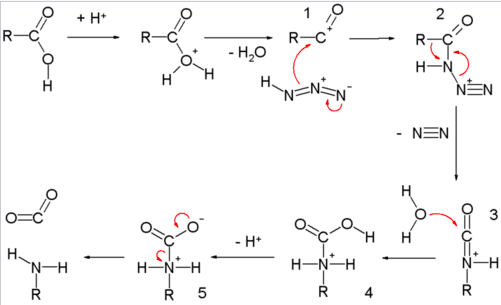Schimdt Reaction
About Schimdt Reaction
This is the reaction between a carbonyl compound and hydrazoic acid in the presence of a strong acid concentrated sulphuric acid. Aldehydes give a mixture of cyanide and formyl derivatives of primary amines, whereas ketones give amides. This reaction closely related to Hofmann and Curtius reaction, of all which involves formation of isocyanate intermediate through the migration of group from carbon to nitrogen. the rearrangement closely resembles the Beckmann rearrangement.


It has been shown to be intramolecular, and Smith (1948) has proposed the following mechanism, which is an example of the 1, 2-shift (from carbon to nitrogen); for ketones :
Reaction Mechanism of Schimdt Reaction
In ketones, if the two groups are not identical, then two geometrical isomers of (I) are possible. It is also reasonable to suppose that the anti group (to the diazonium nitrogen) is the group that migrates. In this way it is possible to explain how steric factors may influence the isomer ratio of amides formed:For aldehydes and so the reaction maybe formulated.

List of Name Reaction of Organic Chemistry consist of detail Reaction Mechanism of all name reactions of Organic Chemistry.
Recent Concepts
- Aldol condensation
- Arndt−Ester synthesis
- Baeyer−Villiger Oxidation
- Benzoin Condensation
- Beckmann Rearrangement
- Cannizzaro Reaction
- Clemmensen Reduction
- Claisen condensation
- Etard’s Reaction
- Friedel-Crafts alkylation
- Friedel Crafts Acylation
- Fries Rearrangement
- Gattermann-Koch Reaction
- Grignard Reagent
- Hell-Volhard-Zelinsky Reaction
- Hunsdieker reaction
- Hoffmann Bromamide Degradation
- Jones reagent
- Kolbes Reaction
- Knoevenagel Reaction









